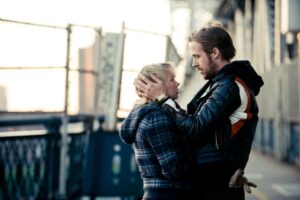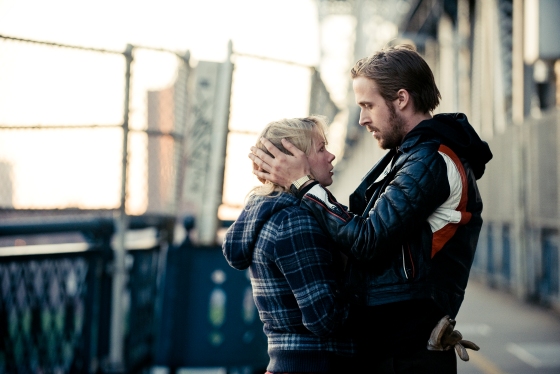
Dean is a simple guy. He’s hopelessly devoted to his wife Cindy and their child. He works when he needs to but spends most of his time at home while Cindy works steady hours as a nurse. With the youthful infatuation Cindy once had for Dean now waning, it might be time for her to move on. But Dean doesn’t want to let her go.
“Blue Valentine” is a triumph of both form and substance. Adopting a structure that will remind viewers somewhat of “Eternal Sunshine of the Spotless Mind” but without the fantasy elements, “Blue Valentine” director Derek Cianfrance who co-wrote the screenplay with Joey Curtis and Cami Delavigne manages to elevate a story that might otherwise be a run-of-the-mill drama. The performances by Michelle Williams and Ryan Gosling as Dean and Cindy are certainly top-notch, and the emotional tug of the very personal narrative sincere. But by manipulating the time line and giving us the history of this ill-fated romance in a unique and interesting manner, “Blue Valentine” proves to be something special.
You see, the structure of this tale is not completely linear. Things become a bit unstuck in time. We get glimpses of the couple’s relationship through the years, from their initial meeting to the present. It is a very familiar story to many of us who have been in and out of relationships. Everything that happens in the film feels utterly real and let me warn readers, “Blue Valentine” is a bit of a downer. We learn certain profundities about the characters. Dean is a very humble working-class guy who will be true to his wife to the bitter end. However Cindy, who once used Dean as a way to unnerve her conservative parents, no longer is taken in by Dean’s baseness and uncomplicated charm. We know that they are headed for a crash, but just how will things grind to a halt? And just when the story seems to be going in one direction, we see something from the past that gives us a bit of hope that their love will carry them forward. The careful intertwining of the past and present pulls us into the characters’ plight and makes everything seem more intimate and genuine. By the end of the film, we feel like we know these two and why they make such hard decisions.
Small movies like “Blue Valentine” often benefit from experimentation with visual scope or as here with narrative structure. When the budget is small risks can be taken. But when a tiny film like this also attracts a talented cast the likes of Ryan Gosling and Michelle Williams, there is additional pressure to deliver a story that gives such actors something challenging. Anything with Gosling and Williams will play every large film festivals, get theatrical and home distribution, and be subjected to a great amount of critical scrutiny. Smartly, filmmaker Cianfrance keeps his story very tight focusing on just a few characters and permitting the actors to experience the emotions as they craft their roles. And to up the ante, the structure choice, a real gamble, dove-tails extremely well. Bound to spawn other imitators, I seriously doubt the magic achieved here could be repeated as successfully. “Blue Valentine” is a rare excellent combination of both style and substance.


